Historic Nottingham - Part 3 - Canal Walk (Wilford Street
end)
w/e 13 May 2007
All this week's pictures were taken
with a Kodak DX6490
Prompted by Malcolm Sales' book "100 Walks In
Nottinghamshire" I chose "Historic Nottingham"
as the title for this series but as we shall see in this and
the next part, it could just as easily have been "The Changing
Face Of ...". If you'll excuse the mixed metaphors, while
we will keep one foot firmly in the past as we follow the route
along the Nottingham Canal, we will have the other firmly planted
in the present and as will become obvious in Part 4, we will
also have at least one eye on the future. But in years to come,
that too will be a part of history.
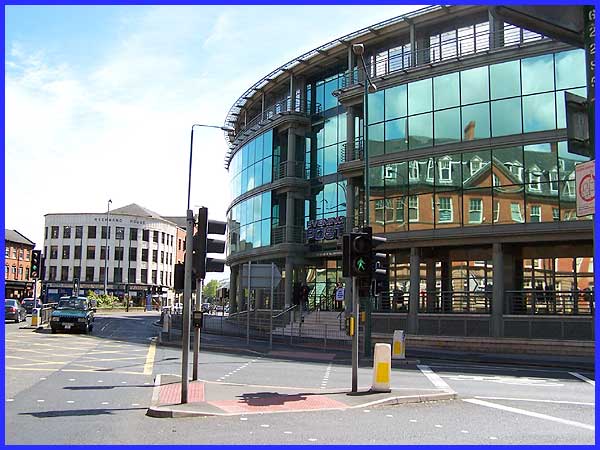
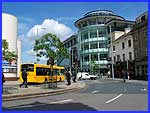 Resuming our
walk on Castle Boulevard near the Brewhouse Yard Museum we must
turn right into Wilford Street to reach the canal and here we
can see the first evidence of the regeneration in this part of
the city that has been undertaken in recent times in the offices
of the Nottingham Evening Post. The newspaper offices were previously
in a building dating from the 1870s on the corner of Forman Street
and South Sherwood Street. Originally built for a large printing
business and the Guardian Journal, the Post's forerunner it was
demolished to be replaced by the Corner House (right). Wherever
you look these days in the centre of Nottingham there seems to
be building work in progress but reflected in the glass of the
new offices above is the older architecture of the Blood Donor
Centre in Castle House on Castle Boulevard. The rear of the Evening
Post's offices now back onto Castle Wharf which has been transformed
with offices, pubs and leisure complex developments. Nearby too
are the Inland Revenue headquarters and the Nottingham Archives. Resuming our
walk on Castle Boulevard near the Brewhouse Yard Museum we must
turn right into Wilford Street to reach the canal and here we
can see the first evidence of the regeneration in this part of
the city that has been undertaken in recent times in the offices
of the Nottingham Evening Post. The newspaper offices were previously
in a building dating from the 1870s on the corner of Forman Street
and South Sherwood Street. Originally built for a large printing
business and the Guardian Journal, the Post's forerunner it was
demolished to be replaced by the Corner House (right). Wherever
you look these days in the centre of Nottingham there seems to
be building work in progress but reflected in the glass of the
new offices above is the older architecture of the Blood Donor
Centre in Castle House on Castle Boulevard. The rear of the Evening
Post's offices now back onto Castle Wharf which has been transformed
with offices, pubs and leisure complex developments. Nearby too
are the Inland Revenue headquarters and the Nottingham Archives.
|
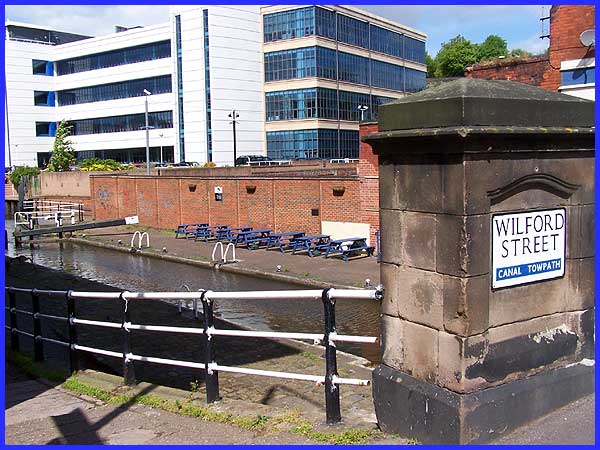
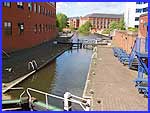 Access to the
canal is via a ramp that leads directly to Castle Lock. The building
pictured above beyond the canal, is an extension of New Castle
House, an art deco style building on Castle Boulevard. An unrelated
walk from Castle Marina in 2002 (link) brought us as far as Castle Lock but
now we will continue to London Road. Beyond Castle Marina however,
the Nottingham Canal originally continued to Langley Mill and
the coalfields to the north. Much of that route is derelict and
the canal now links with the Beeston Canal to Beeston Rylands (which we visited recently)
to bypass an unnavigable part of the River Trent. Access to the
canal is via a ramp that leads directly to Castle Lock. The building
pictured above beyond the canal, is an extension of New Castle
House, an art deco style building on Castle Boulevard. An unrelated
walk from Castle Marina in 2002 (link) brought us as far as Castle Lock but
now we will continue to London Road. Beyond Castle Marina however,
the Nottingham Canal originally continued to Langley Mill and
the coalfields to the north. Much of that route is derelict and
the canal now links with the Beeston Canal to Beeston Rylands (which we visited recently)
to bypass an unnavigable part of the River Trent.
|
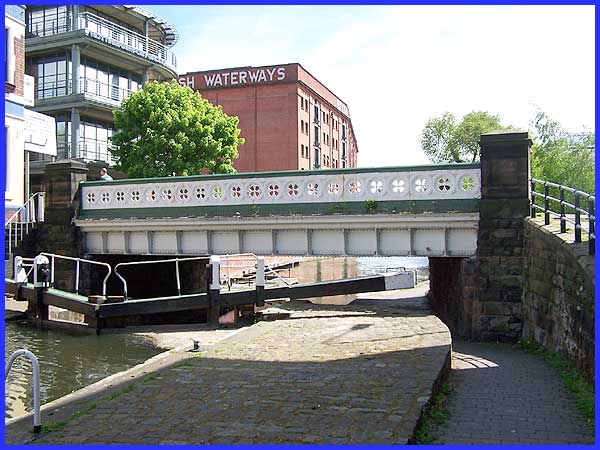
The bridge we have just crossed and must now pass under is a
fine example of decorative Victorian cast-iron work. In this
view we can also see from left to right the corner of the appropriately
named Navigation Inn on the north side of the bridge, the Evening
Post offices and the former British Waterways building.
|
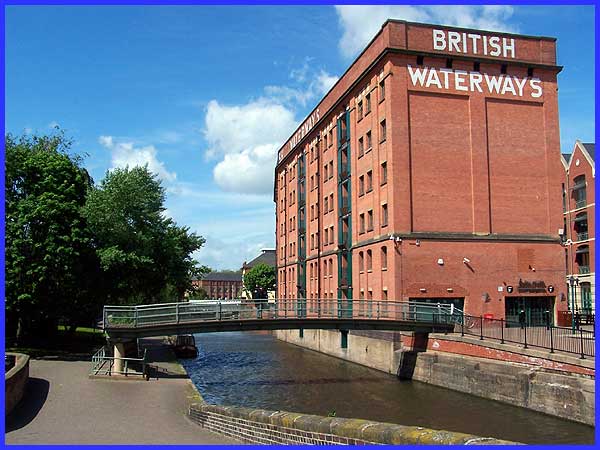
The British Waterways building constructed for the Trent Navigation
Company is a Grade II listed building and is still an imposing
feature on Castle Wharf, long after its original function as
a warehouse ceased. It has now been fully restored and has found
a new lease of life as luxury apartments.
|
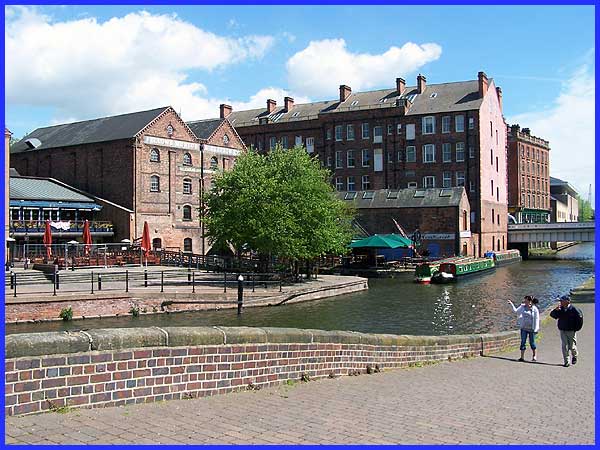
Adjacent to the British Waterways building, Castle Wharf has
seen a great deal of regeneration from its former appearance
which had suffered a number of descriptions among which "squalid"
was often used. The wharf has been transformed with a number
of cafe-bars, pubs, restaurants, health clubs and commercial
ventures that back onto the canal. Many feature open air terraces
and form a unique setting close to the city centre.
|
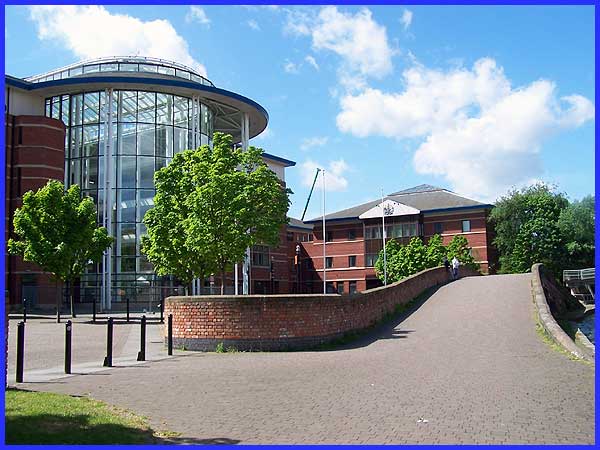
The south side of the canal has also seen a similar amount of
investment. We have already mentioned the Nottingham Archives
and in this picture we can see the new Magistrates' Court (on
the left) and the Nottingham Youth Court. A spur from the canal
used to pass under the bridge seen on the right to run into the
Midland Railway goods yard but the spur now terminates on the
other side of the bridge in an ornamental pool in front of the
Courts.
|

